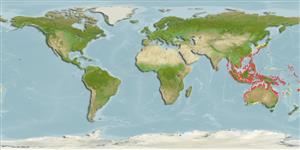Issue
Regarded as nomen dubium (unavailable) in Randall et al., 2014 (Ref. 95583:21)
Environment: milieu / climate zone / depth range / distribution range
Οικολογία
Θαλασσινό(ά); Υφάλμυρο Υφαλόφιλο(α). Tropical
Indo-West Pacific: southwest Sumatra to Bali Strait, and Malaysia (Ref. 5756).
Μέγεθος / Βάρος / Age
Maturity: Lm ? range ? - ? cm
Max length : 15.0 cm NG αρσενικό/απροσδιόριστο; (Ref. 27550)
Inhabits coral reefs and rocky areas (Ref. 27550). Enters estuaries (Ref. 27550). Feeds on crustaceans and polychaete worms (Ref. 27550).
Life cycle and mating behavior
Γεννητική Ωρίμανση | Αναπαραγωγή | Γεννοβολία | Αβγά | Γονιμότητα | Προνύμφες
Gloerfelt-Tarp, T. and P.J. Kailola, 1984. Trawled fishes of southern Indonesia and northwestern Australia. Australian Development Assistance Bureau, Australia, Directorate General of Fishes, Indonesia, and German Agency for Technical Cooperation, Federal Republic of Germany. 407 p. (Ref. 5978)
IUCN Red List Status (Ref. 130435: Version 2024-1)
Threat to humans
Harmless
Human uses
Εργαλεία
Special reports
Download XML
Διαδικτυακές πηγές
Estimates based on models
Preferred temperature (Ref.
123201): 27 - 29.3, mean 28.8 °C (based on 1850 cells).
Phylogenetic diversity index (Ref.
82804): PD
50 = 0.5000 [Uniqueness, from 0.5 = low to 2.0 = high].
Bayesian length-weight: a=0.01380 (0.00591 - 0.03225), b=3.02 (2.83 - 3.21), in cm total length, based on LWR estimates for this Genus-body shape (Ref.
93245).
Τροφικό Επίπεδο (Ref.
69278): 3.3 ±0.38 se; based on food items.
Ελαστικότητα (Ref.
120179): Υψηλό, ελάχιστος χρόνος για διπλασιασμό πληθυσμού < 15 μήνες (Preliminary K or Fecundity.).
Fishing Vulnerability (Ref.
59153): Low vulnerability (10 of 100).
Nutrients (Ref.
124155): Calcium = 91.6 [46.4, 150.3] mg/100g; Iron = 0.688 [0.418, 1.148] mg/100g; Protein = 18.8 [17.7, 19.9] %; Omega3 = 0.121 [0.073, 0.202] g/100g; Selenium = 21.7 [11.6, 40.8] μg/100g; VitaminA = 74.8 [21.9, 250.4] μg/100g; Zinc = 1.66 [1.12, 2.39] mg/100g (wet weight);
